The automotive landscape is constantly evolving, and in the increasingly competitive SUV segment, the Ford Kuga and MG HS stand out as compelling options for buyers seeking style, comfort, and advanced technology. In this comparison, we’ll delve into their technical specifications, innovations, and overall performance to help you decide which SUV makes the ideal choice for your needs.
Ford Kuga vs MG HS – Which one offers the better deal?
Everyday use, family trips or long-distance drives – here’s where the differences show.
Discover whether Ford Kuga or MG HS fits your lifestyle better.
Engine Options and Performance
The Ford Kuga offers a versatile range of engine options catering to various driving preferences. It includes petrol, full hybrids, and plug-in hybrid configurations, with power outputs ranging from 150 HP to a robust 243 HP. The Kuga's hybrid variants boast impressive fuel efficiency, recording consumption figures as low as 0.9 L/100 km, while offering an electric range of up to 69 km.
In comparison, the MG HS focuses primarily on petrol and plug-in hybrid engines, providing power outputs from 170 HP to an impressive 272 HP. The HS’s consumption rates are slightly higher, hitting 7.6 L/100 km for its petrol variants, but the plug-in hybrid delivers an electric range of up to 100 km, showcasing its capability as an eco-friendly option.
Acceleration and Handling
The Kuga impresses with lively acceleration times, recording 0-100 km/h figures ranging from 7.3 to 9.5 seconds depending on the engine variant. This agility, combined with options for both front-wheel drive and all-wheel drive, gives drivers choice and confidence in various driving conditions.
The MG HS matches its rival closely, with acceleration times of 6.8 to 9.6 seconds across its variants. The front-wheel-drive layout ensures good handling and responsiveness, making it an engaging option for urban and highway driving alike.
Interior Space and Comfort
Interior design and comfort remain paramount in the SUV market. The Ford Kuga maximizes practicality with a cavernous trunk capacity of 412 liters, expanding to 545 liters with the rear seats down. For passenger comfort, the Kuga seats five and is equipped with a range of tech features to enhance the driving experience.
On the other hand, the MG HS excels in terms of storage, offering a generous trunk capacity of 507 liters in its standard configuration. The spacious interior design, with ample legroom for both front and rear passengers, makes it a desirable choice for families and road trip enthusiasts alike.
Technology and Innovations
Both SUVs are equipped with cutting-edge technology, but they cater to slightly different preferences. The Ford Kuga incorporates advanced driver-assistance systems and Ford's latest infotainment platform, featuring seamless smartphone integration and navigation capabilities. Notably, its hybrid options come with intelligent energy management systems to optimize efficiency.
The MG HS doesn’t fall short in the technology department either, boasting a modern infotainment system that includes a dual-clutch automatic transmission option for a smoother driving experience. Its suite of safety features, including adaptive cruise control and lane-keeping assistant, provides further peace of mind for drivers.
Conclusion: Which SUV Should You Choose?
The choice ultimately boils down to personal preferences and priorities. If you seek a versatile engine range with hybrid options and cutting-edge technology, the Ford Kuga will serve you well. However, if storage space and an advanced infotainment system pique your interest, the MG HS presents a formidable case.
In the competitive SUV market, both the Ford Kuga and MG HS shine with their unique offerings. Whether you prioritize performance, efficiency, comfort, or tech advancements, either model is equipped to satisfy your driving needs.
Here’s where it gets real: The technical differences in detail
Who wins the race?
The MG HS proves to be edges out slightly and therefore becomes our DriveDuel Champion!
MG HS is the better all-rounder in this comparison.
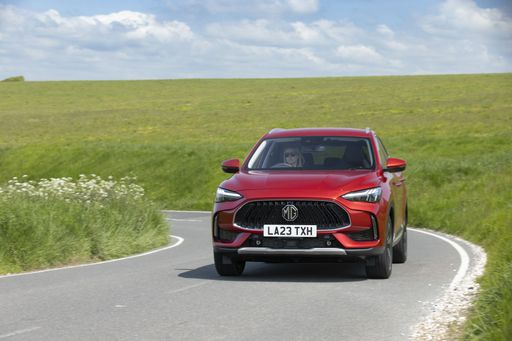 @ MG Motor / SAIC Motor Corporation
@ MG Motor / SAIC Motor Corporation
MG HS
Ford Kuga
The Kuga is Ford’s adaptable family SUV that blends usable space with a surprisingly lively driving character, making daily commutes and weekend escapes equally enjoyable. With smart interior packaging, an easy-to-use infotainment setup and composed road manners, it’s a sensible choice for buyers who want a bit of fun without the fuss.
details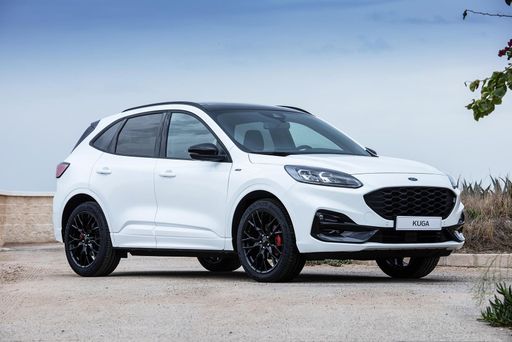 @ Ford Motor Company / Ford Media Center
@ Ford Motor Company / Ford Media Center
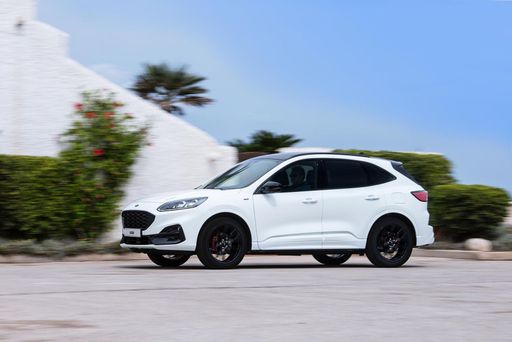 @ Ford Motor Company / Ford Media Center
@ Ford Motor Company / Ford Media Center
 @ Ford Motor Company / Ford Media Center
@ Ford Motor Company / Ford Media Center
MG HS
The MG HS looks sharper than its price tag suggests, pairing bold styling with a roomy, well-finished cabin that feels more upscale than you’d expect. It’s a sensible, well-equipped compact SUV that gives mainstream rivals a run for their money and adds enough personality to make everyday driving enjoyable.
details @ MG Motor / SAIC Motor Corporation
@ MG Motor / SAIC Motor Corporation
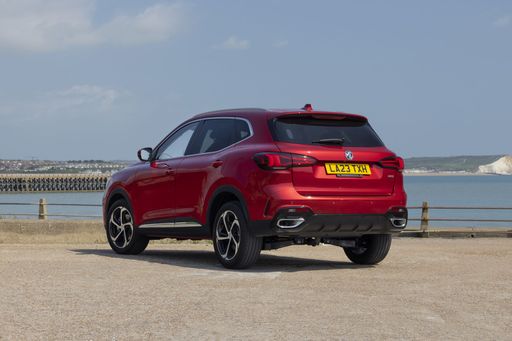 @ MG Motor / SAIC Motor Corporation
@ MG Motor / SAIC Motor Corporation
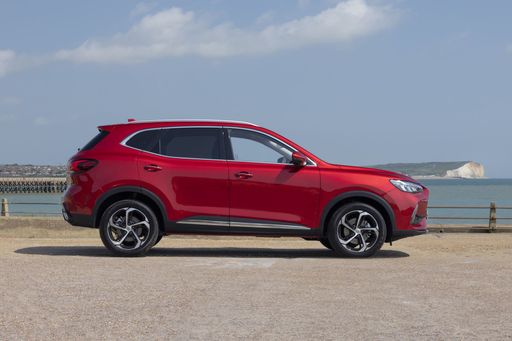 @ MG Motor / SAIC Motor Corporation
@ MG Motor / SAIC Motor Corporation
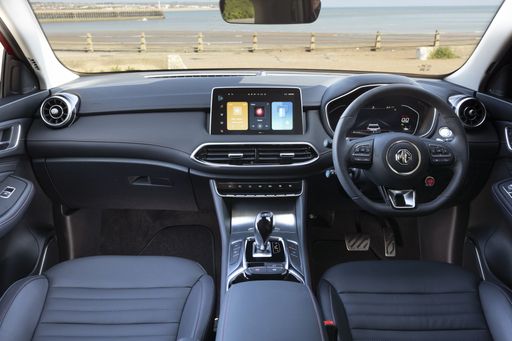 @ MG Motor / SAIC Motor Corporation
@ MG Motor / SAIC Motor Corporation
 @ Ford Motor Company / Ford Media Center
@ Ford Motor Company / Ford Media Center
|
 @ MG Motor / SAIC Motor Corporation
@ MG Motor / SAIC Motor Corporation
|
|
|
|
Costs and Consumption |
|
|---|---|
|
Price
34200 - 46300 £
|
Price
-
|
|
Consumption L/100km
2.8 - 6.8 L
|
Consumption L/100km
-
|
|
Consumption kWh/100km
-
|
Consumption kWh/100km
-
|
|
Electric Range
68 km
|
Electric Range
-
|
|
Battery Capacity
1.1 - 14.4 kWh
|
Battery Capacity
-
|
|
co2
55 - 154 g/km
|
co2
-
|
|
Fuel tank capacity
42 - 54 L
|
Fuel tank capacity
-
|
Dimensions and Body |
|
|---|---|
|
Body Type
SUV
|
Body Type
-
|
|
Seats
5
|
Seats
-
|
|
Doors
5
|
Doors
-
|
|
Curb weight
1526 - 1859 kg
|
Curb weight
-
|
|
Trunk capacity
412 L
|
Trunk capacity
-
|
|
Length
4604 - 4645 mm
|
Length
-
|
|
Width
1882 mm
|
Width
-
|
|
Height
1673 - 1681 mm
|
Height
-
|
|
Max trunk capacity
1534 L
|
Max trunk capacity
-
|
|
Payload
541 - 550 kg
|
Payload
-
|
Engine and Performance |
|
|---|---|
|
Engine Type
Petrol, Full Hybrid, Plugin Hybrid
|
Engine Type
-
|
|
Transmission
Manuel, Automatic
|
Transmission
-
|
|
Transmission Detail
Manual Gearbox, CVT, Automatic Gearbox
|
Transmission Detail
-
|
|
Drive Type
Front-Wheel Drive, All-Wheel Drive
|
Drive Type
-
|
|
Power HP
150 - 243 HP
|
Power HP
-
|
|
Acceleration 0-100km/h
7.3 - 9.9 s
|
Acceleration 0-100km/h
-
|
|
Max Speed
195 - 200 km/h
|
Max Speed
-
|
|
Torque
240 Nm
|
Torque
-
|
|
Number of Cylinders
3 - 4
|
Number of Cylinders
-
|
|
Power kW
111 - 178 kW
|
Power kW
-
|
|
Engine capacity
1496 - 2488 cm3
|
Engine capacity
-
|
General |
|
|---|---|
|
Model Year
2025
|
Model Year
-
|
|
CO2 Efficiency Class
E, D, B
|
CO2 Efficiency Class
-
|
|
Brand
Ford
|
Brand
-
|
What drivetrain options does the Ford Kuga have?
The Ford Kuga is available as Front-Wheel Drive or All-Wheel Drive.
The prices and data displayed are estimates based on German list prices and may vary by country. This information is not legally binding.
